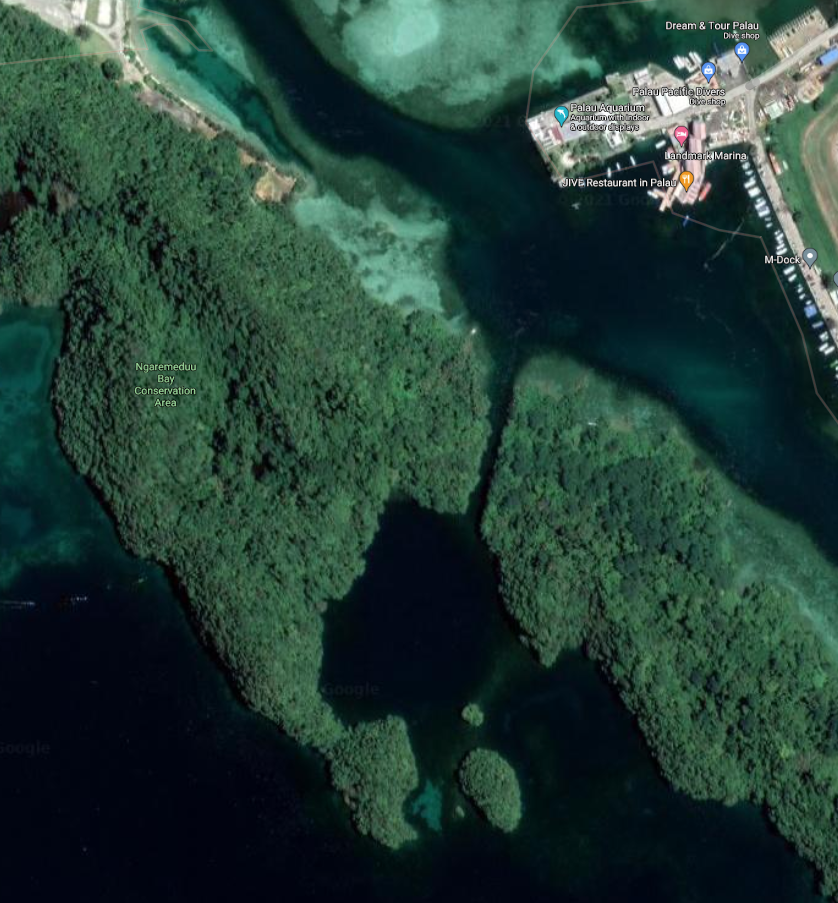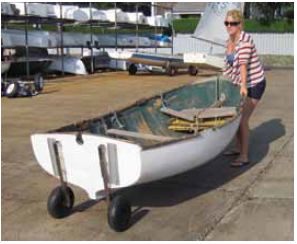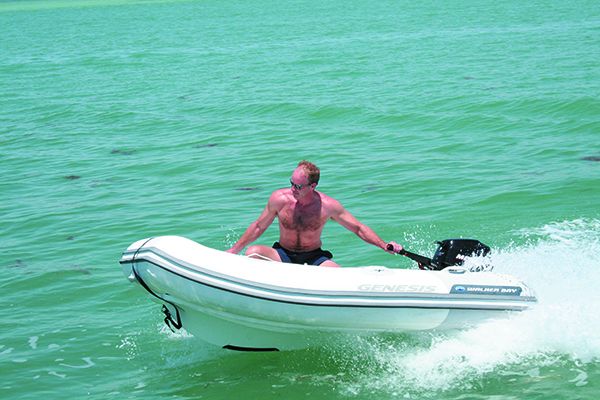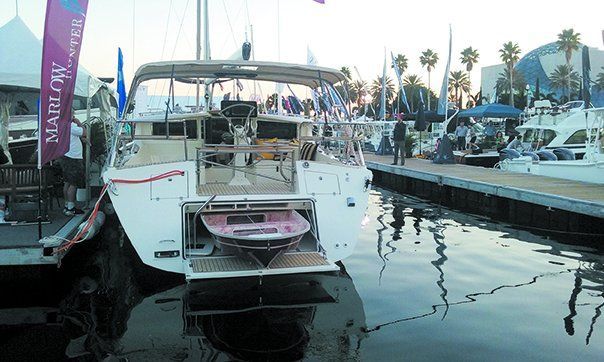Dinghies are the Rodney Dangerfields of cruising. They get no respect, or at least not as much as they deserve. The little boat that will see nearly as many sea miles as the mother ship is too often an afterthought.
Inflatables, and rigid inflatable boats (hybrid “RIBs” with inflatable tubes and rigid bottoms) have been the norm for years. I recognize the virtues of the RIB design, but when it comes to full time cruising, my allegiance remains with the hard dinghy camp. A hard dinghy is virtually indestructible compared to an inflatable or RIB. It’s economical, and it’s always ready to deploy.
There are almost just as many reasons why hard dinghies are the wrong solution. They are harder to stow, hard on topside paint, relatively unstable, and require more patience when getting from here to there. Rowing dinghies are less popular among most cruising sailors for a reason.

If you’re an avid diver or surfer, like to explore, or prefer anchoring away from the crowd, having a RIB or inflatable with a turn of speed will be essential. Having that extra umph also comes in handy when setting kedges, playing tugboat, or rushing to help a neighboring boat whose anchor has begun to drag. They are also a big help when trying to overcome strong currents. This last point struck home in Palau as we rowed and used our 2 hp Mercury to creep through a narrow cut to reach the local port. Needless to say, we were the thirstiest patrons at the bar during the springs and neaps.
Ultimately, our dinghy preferences reflect our philosophies toward cruising. The romantic drawn to the idea of self-sufficiency (the person who rides a bike to work), will be inclined toward a rugged hard dinghy that rows easily and requires virtually no maintenance. The pragmatic RIB aficionado will recognize that having fast transportation is worth the hassles associated with an internal combustion engine.

Years have past since our last head-to-head dinghy tests (see PS November 2009, October 2008, and July 2008). Both focused on inflatables. Since then, there have been a few interesting inflatable designs like Takacat and other iterations of the twin-hull design, but we have seen some interesting developments in hard dinghies.
Several years ago, West Coast designer Russell Brown came out with a kit for the PT11, a dinghy comprising two parts that nest inside each other. And the carbon-fiber Wing Dinghy, which we compared to the popular Trinka in October 2009, is so light that one person can easily load and stow it.
Since the wide introduction of the mass produced Walker Bay 8—a relatively sedate rower with a durable thermo-molded PVC hull—the more traditional fiberglass dinghies have been pushed to the fringes of the market. The familiar names-Bauer, Fatty Knees, Trinka, Dyer, Gig Harbor-are still around, but the prices ($6,000 for a sailing Dyer) make an upwind slog in $600 Walker Bay 8 seem more tolerable. Kit boats like Brown’s PT11 or those from Chesapeake Light Craft offer a cheaper path to a hard dinghy. It requires an investment in time, but the experience gained building your own dinghy can be more valuable than the boat itself.

As we begin another round of dinghy testing, we’d be interested in hearing from readers. How long have you had it? What problems have you had? And where the heck do you stow the thing? You can contact me at practicalsailor@belvoir.com.


































Sadly the PT 11 is no longer available. I tried to buy a kit for a project this Winter and the owner replied they are getting out of the business or at least taking a break for the foreseeable future.
Hi Brian,
I have a PT 11 that Russell Brown personally built. I haven’t decided whether to sell it yet, but I have toyed with the idea. Russell built a new rudder and dagger board for it when I purchased. It is still in very good condition. You may be more interested in the project of building your own, but should you be interested in purchasing mine, let me know. It’s a joy to sail.
Gail Hafelfinger
I see that PT11 kits will be available again “soon” which is good. Would prefer to purchase a used one so if you still have yours and are still considering selling would like to discuss.
You can get the PT11 from Chesapeake Light Craft.
https://www.clcboats.com/shop/boats/wooden-sailboat-kits/PT-11-Nesting-Dinghy.html
We purchased a 3 m OC Tender in NZ in 2018, built there by a very experienced cruising couple after circumnavigating.
Worth a peruse if you want to divorce yourself from air pump addiction.
I bought inflatabels, two of them, both secondhand. Both of them started falling apart at the seems – literally – after a few weeks. Given up on dozens of patches and daily pumping, I now have a secondhand Pioner 8. While it is a bit too small for my nearly 90 kgs, it is so sturdy I think you can literally throw it off a cliff and get underway. It develops decent speed with a 12V electric outboard too. Downside is it is quite heavy for its size, 50 kgs or something. I store it upright on my swimming platform 🙂
The Offshore Cruising Tender out of New Zealand seems to be the gold standard for a hard dinghy today. https://octenders.co.nz/ Would love to read a review on them one day.
What is your opinion of the Portland Pudgy?. My partner and I bought one a couple of years ago as tender to our Mirage 27. She (the tender!) Is a lot of fun to have, apart from the obvious uses, very safe,. I must add that my partner is 81 and I am 94. We confine ourselves to pottering about in the Solent these days, but the sky is the limit!!. Gordon James.
For me. my old 8 1/2 foot inflatable Avon is the best for several reasons. 1) I can see over it when it’s upside down over the cabin while looking through the dodger. 2) It can quietly bump the mothership like a fender for hours. 3) I can stand up while pulling crab traps. 4) I can load it myself without using the halyard if necessary.
The inflatable PVC floor died awhile back so I traced it on 1/2 inch marine plywood, cut it out, and carfully rounded all the edges and finished with a Dallys product. Works very well, maybe better than the old high pressure inflatable floor. Hasn’t chaffed the hypalon yet.
Old sailors never die, they just get a little dingy.
I was practically given a Walker Bay 8, replete with sail package option and two sails to boot. After going through two inflatable dinghy tenders on my Westsail 32, I added the optional horseshoe-shaped inflatable collar to it. Now it is a very stable dinghy for two adults and a couple bags of groceries. I can still hoist onto the foredeck with the spare halyard. When I am inclined to do some exploring or need to move around quicker than rowing it, I put a Suzuki 2.5hp on it. Moves along very nicely. The WB8 is virtually indestructible and tows well with the inflatable collar, which I made chaps for to protect against UV destruction, the mortal enemy of any inflatable, next to sharp objects. Lastly, if my son and his are aboard I can stow the 2-part mast, rudder/tiller and daggerboard in the forepeak, so they can sail around. Only grievance to the now RIB-like WB8 is the increased weight.
I would like to hear from those who have a folding rigid boat like Port-a- Boat (sp?).
Vernon
Me. In my 7th year with complaints.
Pls disregard. Cannot delete.🤔
Regarding a foldable, see my comment on F-RIB.
If your preference is for an easily stored, rigid bottom inflatable that can take multi-mile trips with a motor, and is also pleasant to row on mellow water, it works well. 9-footer is about 80lbs I think.
Here is a link to an article my friend Michael Bogoger posted on his blog Doryman some years back, about the Chameleon I built. I recently built a very lightweight variation as well, and I’d be happy to discuss any of this.
http://dory-man.blogspot.com/2009/08/chameleon.html
I would not part with my 8′ Fatty Knees. It rows and sails nicely in blustery weather and has allowed me to get along happily w/o outboard maintenance and the smelly fumes of stowing gasoline onboard. Also, a small spray dodger I made from polycarbonate, attaches to the bow with swivel fasteners and keeps out whitecaps. I prefer the Fatty Knees to my inflatable dinghy and even my inflatable liferaft, as unlike inflatables that get tossed around in the wind, I can usually point it where I need to go, it is unsinkable, and has a dry locker large enough to stow a manual desalinator pump, GPS, VHF radio for hailing ship traffic, etc. It sits upside down together w/it’s 2-piece mast on the foredeck of my Tayana 37 (since removal of the stay’sl boom which makes for safer cruising when going forward anyhow). It is also much easier to launch and bring back aboard since adding port & stbd lifeline gate attachments forward. The 9′ version of the Fatty Knees sails and rows more efficiently, but would have taken up needed space on the foredeck.
Me. In my 7th year with no complaints. Teamed with the last year(?) of the Nissan 3.5 2 stroke. (I think someone else is still making them) 8’ holds 2 adults or 1 with stores. They finally nailed the transom issues imo. Stows behind the mast or folds down into a paddle board carry sling for storage on the starboard rail. Also can fit into the cabin for lengthy storage. Tipsy? Over blown wives-tale from non-owners that mebbe heard something somewhere from someone 😱
I’d be interested in a review of Whaly boats.
Yes, the RIBs are the predominant choice in the cruising community, especially in the Caribbean but I prefer the rigid choices. Maybe I am not keen on the idea of the RIBs value going to zero after the tubes give up. I have had many rigid dinks over the years from prams to the Dink to an old derelict that I refurbished, even built an 8 ft Dudley Dix design out of marine ply (still have it), to now a 9′ Fatty Knees with a sail rig. Love the FKs, rows quite nicely but motors just OK. I am now convinced that the OC Tender will be my next one as it has pretty much all of the attributes of a RIB without the negatives. It has positive floatation, great storage capacity, very light weight in the carbon fiber, rows decently and planes with minimal HP. I put a deposit on one recently…….I’ll be like a kid at Christmas when it arrives! The only negative (and it is considerable) is the price, but how many RIBs have you bought over the years?
One more thought about the polyethylene boat like Portland Pudgy and the Whaly, they also would make a great choice and their price tag isn’t out of the question but their weight is something to seriously consider, they are often over 100 pounds heavier than a comparable fiberglass dinghy or RIB and that to me is a huge negative, especially the older I get and when pulling up the dinghy on a beach or lifting in the davits. Otherwise, they are pretty much indestructible. Not sure how they row but I guess the PP would be better at that than the Whaly.
F-RIB! Fiberglass hull inflatable, hinges/folds in three parts. Stores like a soft floor, rides like a rigid hull, tows effortlessly for day trips on calm days.
I can store the 9’ version inflated on the foredeck, or folded and lashed ahead of the dodger, or down below for heavier passages aboard my J/42 (which isn’t a great boat for handling/storing a dinghy).
I’ve been thrilled with it for about three years now. Must take care when landing the fiberglass hull on a rocky shoreline.
I don’t know why I don’t see more out there. Probably because their marketing and support isn’t very good.
We have a CLC Passage Maker take a part dinghy on our GB42. At under 100lbs, lifts easily with block and tackle with our wooden boom and nests above our aft master stateroom. Rows great, but range is a concern with an electric motor.
Roll-up with high pressure floor.
We can’t easily store it on the foredeck unless it’s deflated. Towing (almost always) creates drag, stress on the D-rings especially with seas running. After 6 years, I would consider something that rows much better, that doesn’t completely occupy the foredeck limiting access to anchor locker, rode, etc.
Two years ago, I sold my 9.5’ Inflatable and bought a 14’ F-RIB. This is on the large size for a dinghy, but we use it for everything. It tows like other ribs and with deflation of the bow tube folds to fit on my foredeck. It has four sections which provides options for a boat this size. Not too many 14’ ribs will fit in the back of a Subaru. For a pure dinghy, a smaller size would be more practical.
Hi folks, just reading todays waypoints and wondered if anyone has experience building a pram (wood) tender. As a trailer sailor, due to costs, my only option is a build it. I like the look of the Portuguise pram. eg https://hvartial.kapsi.fi/dinghy1/simboii.htm
I’ve had a 7’11” Dyer rowing dinghy for 40 years and few things have given us more pleasure than dropping the hook and rowing around our anchorage exploring the different coves and beaches. Yeah, it’s not stable like an inflatable but, no moving parts and totally romantic.
I want to put in a word for a good rowing inflatable without a hard floor. That is the Mercury 240 soft bottom 7′ 11″. The reason this dinghy rows well is it has a V bottom created by an air filled longitudinal center rib, with the air filled floor over it. I love rowing, and this boat dinghy rows well even in some sea and wind, although it of course gets wet. I can row up two other adults of normal weight, depending on sea and wind. I have had mine for 6 years now and it has held up well with some minor maintenance, mostly with the oar/oarlock assembly. It appears that this design is only available in an 8′ 10″ model which is quite a bit heavier. The 7′ 11″ model stores, deflated, like a large life raft, weighing in at around 60 lbs. Perhaps there is something else comparable on the market.
I love my 2.8m Island inflatable, with a non-folding deep-V aluminium bottom, coupled with a 2.5hp four-stroke Suzuki. It has quite innovative oars, too – the articulated connection to the rib holds the blades vertical. Of course to a traditional rower, this is almost a crime! But for emergency rowing in bad conditions you know that can you put the blade in the water, it’s at the right angle to pull.
I have found it fantastic to work out of to, when maintaining our boat because with the DV you’re standing at least a foot underneath the surrounding water and the is thus extremely stable.
Dictation is not completely reliable!
I have found it fantastic to work out of too, when maintaining our boat, because with the deep V bottom, you’re standing at least a foot underneath the surrounding water and it is thus extremely stable.
Have had several inflatable dinghies. The first was by Metzler, which was very good. Sadly, Zodiac purchased and discontinued Metzler. Second was a Zodiac which was a piece of junk. The floor unglued, and repairs did not help. They knew about the issue, but refused to stand behind their product. Our current is an Achilles, which is still working very well some seven years later. We have used RIBS on charters in the Abacos and BVI, which also worked well, but for our purposes (going ashore when anchored out, and short sight seeing trips) were not worth the added weight and cost.
We have a 2011 8’10” Walker Bay Genesis 270 LX Light RIB. We use a Honda 2.3 HP Air cooled outboard on it. The dinghy’s size & weight works perfectly for our 34′ PDQ Powercat’s davits. While the dinghy is getting old, the 3 chambers still hold air. We are in the market looking for a similar size replacement. There are not many choices in this under 9 ft. size. Walker Bay is still selling this model, but seems to be in the process of replacing it with model with a slightly deeper V-hull but not flooring (like our older model).
I’ll be very interested in seeing how your study shapes up.
I needed an 8′ dinghy to mount on the swim platform of my Albin 36 trawler. Looked at a number of those in the marketplace and settled on the Portland Pudgy. It has proven to be everything it claims to be. I’m delighted with it.
https://portlandpudgy.com/. Delightful folks to deal with too. Watch the videos.
Surprised to see no discussion of inflatable kayaks which, in my experience, make the best tenders. Very stable, easy to re-board in the extremely remote event of a capsize, unsinkable, great weight capacity for their size, light weight and easy to load and unload, tow cleanly with absolutely no drag penalty, self bailing, no need for the weight and complexity of an outboard motor, no need to carry gasoline…the list of advantages goes on and on. Silent and low visual impact for wildlife viewing, forward facing for better looking at scenery and wildlife than a rowing boat, good healthy exercise, relatively inexpensive, don’t bang against or mark the boat hull, can be deflated and rolled up for storing on long offshore passages, and are extremely durable and resistant to puncture (and easy to patch should one ever get punctured). No need for davits, don’t have to be registered, don’t hang off the stern but instead stow neatly on deck in most cases. They’re particularly good on smaller boats, and if the boat has a little more room it can carry two or three so each person can have his/her own paddling excursions. I’ve used them many years for coastal cruising here in Alaska and wouldn’t have anything else. I know bluewater cruisers who love them as much as I do. In the tropics, cover with a tarp or fitted cover to prevent sun damage of PVC over time. Select a model with a tracking skeg or inflatable keel rather than a whitewater boat so that it tracks straight and is easy to handle in the wind.
Owned a Jolly (Ft Meyers) for 30 years. Lightweight fiberglass (circa 100 # ,8 ft) and can haul it up on a dock by myself. Underway -on davits or a painter. Retractable centerboard, ample rudder and Lateen rig for 2 section mast, camcleat, oarlocks and transom guard for 4 hp Yamaha ( 2 and 4 stroke) have made this a lifer for me. Can transport 4 adults in calm water (balancing required). Have no desire for a replacement
I have had a Porta-Bote as a dinghy for about 15 years and it has been versatile and durable. It is just starting to show signs of wear. It tows well, rows well, motors well, is very stable. It never leaks air or water. The flexible bottom takes a bit of getting used to, but not a big deal. At the end of the season, I fold it up and leave it on the deck under the tarp. I love it and would buy another if this one wears out!
Love my Portland Pudgy. Does what they say. Rows. motors, tows, and sails surprisingly well. It is also our life boat with. It’s canopy. Tough, stable, and unsinkable.
Love my PT-11. Rows like a dream and sails even better. A bit tight for my wife and I and two kids, but we’ve managed in settled weather. Still might end up getting iRIB, but I love having a ailing dinghy to cruise the anchorages.